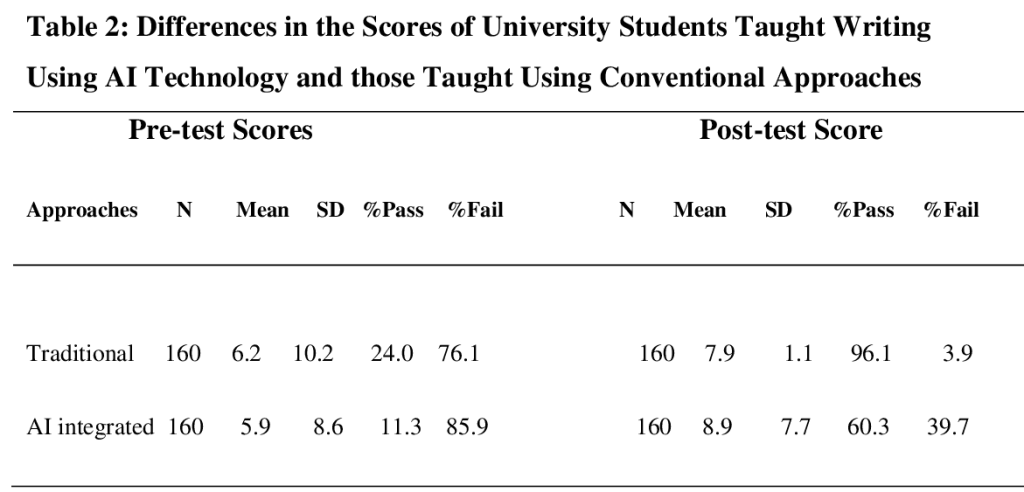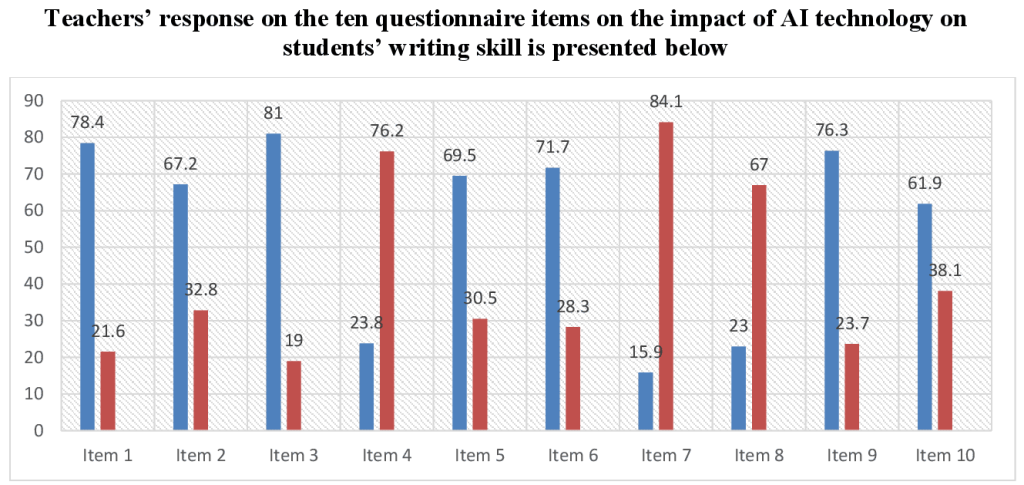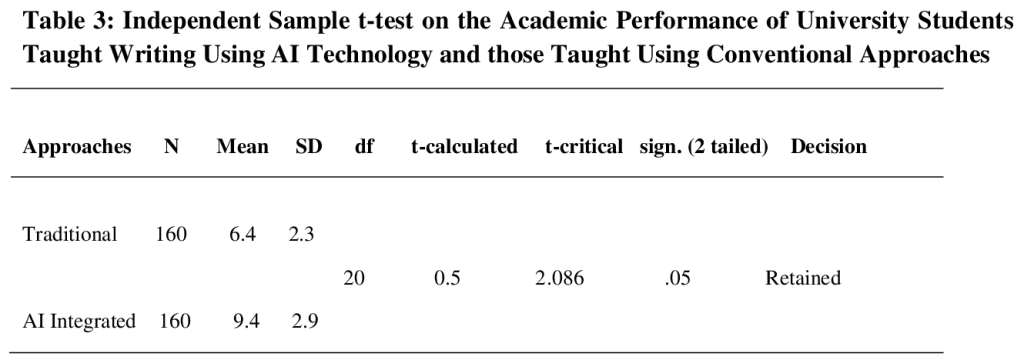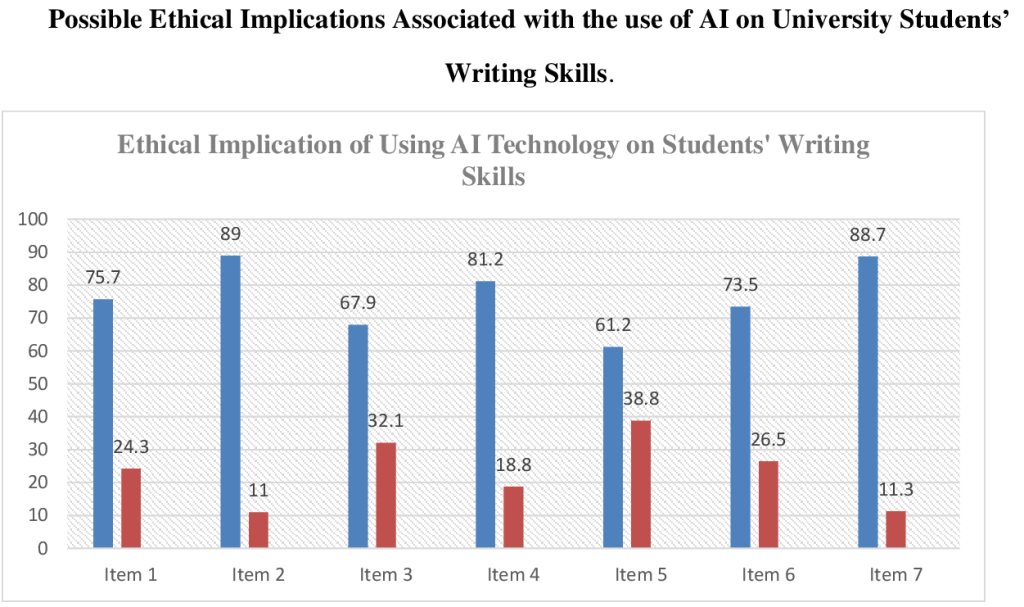
Jointly published by The Division of General Studies, Chukwuemeka Odumegwu Ojukwu University, Nigeria (formerly Anambra State University) and Klamidas.com Global Online Journal of Academic Research (GOJAR), Vol. 4, No. 1, February 2025. https://klamidas.com/gojar-v4n1-2025-06/ |
||||||||||||||
|
Exploring the Impact of Integrative Artificial Intelligence Tools on the Writing Proficiency of University Students in Kano State
Mudassir Hassan & Adebayo Abubakar Funsho
Abstract The integration of artificial intelligence (AI) tools in educational context has significant implications for students’ writing skills, often resulting in detrimental effects. Current scholarship highlights that while AI tools offer certain advantages, overreliance on them can lead to cognitive offloading, which in turn diminishes critical thinking abilities and stifles creativity. This study aims to assess the impact of AI tools on university students’ academic writing skills, as well as to examine the ethical concerns surrounding the adoption of AI technologies in writing processes. Employing mixed-method approach in the study, data were collected from three hundred and twenty (320) university students and fifty (50) language teachers via questionnaire, pre-test and post-test scores from essay writing tasks. Data collected through questionnaire were analyzed descriptively, while inferential analysis was employed to address the stated hypotheses. Findings of the study reveal that the presence of AI tools reduces students’ capacity to produce high-quality academic discourse and promotes unethical practices. Therefore, the study reveals significant negative impact of AI on students’ writing capabilities and the prevailing manifested trend of cognitive offloading. Based on the findings, it is recommended that teachers and relevant stakeholders adopt AI tools as complementary resources, while reinforcing traditional writing methods that nurture critical thinking, creativity and students’ expression. Keywords: Artificial Intelligence, cognitive offloading, ChatGPT, writing proficiency, creativity Introduction The significant advancement in information and communication technology (henceforth, ICT) that has uniquely defined the 21st century creates an environment that encourages human-like thought or cognitive-like content produced by artificial cognitive systems. This major shift suggests that the era of unchallenged human cognitive supremacy is no longer predominant, particularly when it comes to content generated through human thought processes. In fact, this transformation has been largely driven by the recent emergence of artificial intelligence (henceforth, AI). While scientists applaud this remarkable achievement in Science and Technology, this revolutionary trend has simultaneously sparked extensive discussions among scholars. In the context of teaching and learning, there is an increasing concern about the potential negative effects of this technology on students’ ability to engage actively in academic endeavours related to self-generated intellectual discourse, creativity and critical thinking. Some scholars argue that the absence of comprehensive preventive measures to regulate students’ indiscriminate use of AI-generated content, which they present as their original work, is pedagogically detrimental. In addition, the widespread adoption of AI technology has the potential to diminish students’ writing skills, creativity and critical thinking. On the other hand, other scholars maintain an optimistic view of AI’s role in enhancing students’ writing capabilities. They contend that advancements in AI can be effectively harnessed to augment and complement human efforts, regardless of the specific context in which they are applied. As a result, the applications and complementary functions of AI are diverse. These different perspectives have led to renewed interest in assessing the positive contributions of AI technology in education. Therefore, the primary focus of this study is to examine the potential threats posed by AI technology and its associated online platforms, such as ChatGPT, on the writing abilities of university students in Kano State, Nigeria. Aim and Objectives of the Study The present study seeks to investigate the potential effects of AI on students’ writing proficiency. Specifically, it explores the influence of AI tools and technologies, including Automated Writing Assistants and Language Generation Technologies (henceforth, LGT), on the writing skills of university students. In addition, the study has the following objectives:
Research Questions The following research questions are set to guide the study:
Research Hypothesis HO1: There is no significant difference between the learning outcome of university students taught writing through AI technology and those taught using the traditional approach in Kano State. HO2: There is no significant impact of ethical issues associated with the use of AI tools on students’ writing skills. Review of Previous Related Studies The inclusion of AI within educational context has attracted considerable scholarly attention in recent years, particularly concerning its implication for students’ writing proficiency. Empirical studies and scholars’ views show divergent perspectives. Some suggest that the integration of AI technologies can effectively support and enhance multiple facets of writing skills by offering positive personalized feedback, providing linguistic assistance and promoting creativity, as well as enhancing language usage (Yarima, 2024). On the other hand, others believe that AI technologies have significant negative impact on students’ ability to write excellent academic discourse. The primary concerns regarding AI effect on students’ writing include detrimental over-reliance on AI tools, erosion of critical thinking and creativity, undermining of fundamental writing skills, harmful impact on academic integrity, as well as possible overall decline in students’ writing ability (Hassan, 2024). Studies conducted by Idham, Rauf & Rajib (2024), Zafrullah, Meisya & Ayumi (2024), Psatama & Hashuti (2024), Risang (2023), Ramadhan et al. (2023), Cascidy (2023 in Yarima, 2024) and Bhutoria (2022) indicate that AI-based writing assistance tools such as grammar checker and Automated Content Generators facilitate and enhance various aspect of students writing proficiency. Idham, Rauf & Rajib (2024) report that AI tools provide useful personalized feedback and instruction which are significantly useful in providing tailored suggestions for improving students’ writing skills. In addition, Zakrullah, Meisya & Ayumi (2024) indicate that AI tools enhance writing capacity of students, while Psatama & Hashuti (2024), Risang (2023) and Ramadhan et al. (2023) argue that AI tools, not only improve students writing skills, but motivate students’ active practical participation in writing processes which is a radical positive departure from the traditional teacher-centered approach. Moreover, Malik et al. (2023) explores the impact of AI technologies in academic essays writing using a case study design. The study involved 245 undergraduate students from 25 tertiary institutions in eastern and central Indonesian provinces. Data for the study were collected through online questionnaire instrument. Findings of the study reveal that AI tools enhance students’ writing abilities, develop self-efficacy and academic integrity. Furthermore, studies conducted by Aljuaid (2024), Teng & Wang (2023) and Zhao et al. (2023) indicate that AI tools improve students’ writing proficiency and boost their confidence and productivity during the writing process. One of the primary concerns regarding AI on students writing is the risk of students developing an over-reliance on AI-based Writing Assistance Tools (ABWAT), such as grammar checkers and automated content generators. Studies by Basha (2024) and Perkins (2023) indicate that AI technologies ChatGPT can generate unique and logical content that can evade detection, giving rise to significant concern over academic integrity. In addition, it is indicated by the findings that AI tools negate the development of basic foundation skills, critical thinking and make students inactive in academic performance. Similarly, studies by Budai & Backer (2020 in Yarima, 2024), Borenstien & Howard (2021), Kyoungwon et al. (2021 in Yarima, 2024) and Abd Rahman et al. (2023 in Yarima, 2024) reveal that students who depend heavily on AI tools, experience a significant decline in their ability to write. Besides, AI tools provide a false proficiency level of students, thereby disallowing teachers to locate students’ deficiency. In a recent study conducted by Yarima (2024), it is revealed by the findings that AI tools make students less motivated to engage in the repetitive process of writing, as they perceived AI tools as a shortcut to producing polished writing without investing the necessary effort. In the same vein, it is affirmed by Turner (2024) that when students use AI tools to generate ideas and compose entire texts, originality and innovative thought in writing become stifle. In addition, Adamu (2024) argues that AI tools can lead to shallow analyses and weakened argumentative writing skills. Besides, findings of the studies conducted by Lydia (2023 in Yarima, 2024) and Derrida (2022 in Yarima, 2024) reveal that AI tools diminish students’ ability to write, render them less attentive to grammar usages, spelling, correct use of punctuations, erosion of critical thinking, originality, as well as encourage unethical problem of plagiarism. Based on the scholars’ assessments and the results of studies conducted on the impact of AI tools on the writing proficiency of students, it is clear that the new technology has a significant impact on students’ writing skills – positively and negatively. Parts of the positive impact include the provision of real-time feedback on grammar, style and structure and provision of effective guide to students on how to improve their writing efficiency. The technology does not only provide students with opportunity to generate ready-made written content, which support brainstorming, but facilitates personalized learning opportunities, offering tailored suggestions that help students improve their writing proficiency. On the negative perspectives, the technology reduces students’ critical thinking ability due to over-reliance on AI technology for assistance. Though AI can be a powerful tool for enhancing writing skills, it should not be used in conjunction with traditional learning methods to ensure a well-rounded development, as well the development of critical thinking skill which is one of the cardinal objectives of writing skills (Hassan, 2024). What is more, with AI associated language problems of a learner cannot be exposed, as the writing is not done by him. Therefore, deficiencies in language usage cannot be seen and corrected by teachers. The clear gaps identified in the previous studies on the effect of AI technology on students’ writing skills include the fact that most studies, if not all, were carried out in Europe and Asia, with only a handful conducted in African nations. Besides, majority of the studies focus on learners of English as a Foreign Language (EFL). In contrast, this study is conducted in Kano State, located in North-West Nigeria, within the West African sub-region. Additionally, this study involves learners of English as a Second Language (henceforth, ESL) According to Catherine (2023 in Yarima, 2024) writing ability refers to “the capacity to communicate effectively through written language, allowing students to express their ideas, thought and feeling by demonstrating good command of language usage and organizational skill.” Writing ability enables university students to excel both academically and professionally, while also enhancing their personal lives (Yarima, 2004). Writing encompasses a series of sequential activities leading to continuous learning process. Through traditional learning methods, students are consciously and deliberately exposed to different writing activities aimed at developing their critical thinking, creativity, language usage and organizational skills, as well as the ability to develop and articulate their own ideas, rather than relying on content generated by AI tools. From a pedagogical perspective, within the context of English as a Second Language (ESL) education, writing reveals specific areas in which learners may struggle with the target language. This allows teachers to identify such deficiencies and provide the necessary support to help students overcome the challenges associated with language learning in the ESL context for proficiency. According to Febrina and Kartolo (2022 in Yarima, 2024), the teaching of writing is done to achieve several objectives: promoting students to engage in writing with honesty and responsibility, utilizing language with caution, integrity, and sensitivity; stimulating students’ imagination, creativity and cognitive abilities; and producing written works or essays that are well-organized, precise, clear, structured and adhere to formal conventional norms. Similarly, Hassan (2024) asserts that university students are expected to produce writing that is formal and devoid of any informal language usage (Hassan & Sanusi, 2023). In addition, it is anticipated that students at the university level will generate exemplary academic discourse in their capacity as members of the formal discourse communities. However, the advent of AI technology appears to pose a potential threat capable of undermining the objectives and expectations. METHODS Research Design The study employs a mixed-methods design; a quantitative approach using a quasi-experimental design was employed. A pre-test was administered to assess the initial skills levels of the participants in both the control and experimental groups. Following this, the experimental group had the opportunity to use AI tools to generate ideas for writing narrative essays for two weeks, while the control group received instruction through the traditional methods without the integration of AI technology. To evaluate the effectiveness of these strategies, a post-test was conducted simultaneously for both groups. The post-test scores were compared with the pre-test scores in order to assess the impact of AI technology on students’ writing skills. In addition, a qualitative approach was also used in the study, with data collected through a questionnaire and analyzed descriptively. Population and Sample The study population consisted of participants from four selected universities in Kano State. A sample size of one hundred and sixty (160) participants for each group, namely the control and experimental groups, was determined using Taro Yamane guidelines for appropriate sample size selection. A Purposive Sampling technique was employed to select the sample of the study. Research Instrument The study collected data from students’ essays that were given during the pre-test and post-test phases. The students’ writings were assessed using a set of scoring criteria for evaluating students’ writing and for giving feedback, Writing Assessment Rubric (WARU), developed by Spack & Burden (2015). The rubric is widely used by researchers as criteria for assessing writing. It provides a comprehensive and all-encompassing guideline for assessing and scoring writing including content, organization, mechanics, language use and vocabulary as presented in Table 1 below:
A ten items structured questionnaire was also distributed to forty (40) randomly selected lecturers across the four designated universities – ten from each of the universities. The questionnaire was designed in Likert format. The items in the questionnaire sought to elicit data on the ethical concern of using AI tools, as well as the impact of the technology on the writing skills of selected university students in Kano State, Nigeria. Data Collection and Analysis Data collected through questionnaire instrument and from the scores obtained from the writing tasks (pre-test and post-test scores) were analysed by employing inferential and descriptive methods. RESULTS Data Presentation and Analysis Impact of AI Technology on the Writing Skills of University Students in Kano State The Descriptive Result
As shown in Table 2, the pre-test score of the control group shows that majority of the students in the group scored low, as the highest percentage of 76.1% failed, while the low percentage of only 24.0% scored high. Also, the mean score of the result is 6.2. On the other hand, the academic performance of the students in the pre-test treatment for those in the experimental group shows that 85.9% performed academically low, while only 11.3% scored high. The mean of the group is 5. 9, the standard deviation of the pre-test scores is 10.2 for the conventional group and 8.6 for the experimental group. This means that the results of the two groups are the same; as majority in the two groups performed poorly. On the other hand, the results of the post-test indicate that majority of the subjects in the control group of 96.1% scored high, while only 39.7% scored low. Equally, majority of the students, 60.3% scored high, while 43.8% scored low. By comparing the two results, it is evident that the results of the post-test for those in the control group is better as 96.1% passed, while only 60.3% in the experimental group passed. The disparity in the two scores is facilitated by the scoring criteria, which necessitated the removal of certain expressions and usages considered as AI generated. Therefore, teaching writing using traditional approach is most effective in facilitating students’ writing skills.
As shown in the analysis, majority of the teachers agreed that AI technology negates students’ ability to write good academic discourse (78.4%), discourages creativity (67.2%), motivates students’ over-reliance on AI content-generated materials (81%), does not facilitate effective grammar usage (76.2%), encourages laziness (69.5%), encourages plagiarism (71.7%), does not improve students’ proficiency in the use of words (84.1%), fails to guide students’ ability to use punctuations (67%), negates students’ expressive and organizational skills (76.3%) and impedes teachers’ effort to identify areas of learners’ deficiencies in the target language. Conversely, the response patterns of 21.6%, 32.8%, 19%, 23.8%, 30.5%, 28.3%, 15.9%, 23%, 23.7% and 38.1% show the opposite. Therefore, AI technology negates university students’ ability to write good academic discourse. The Non-descriptive Result Pre-test Score
Table 3 shows that there is no significant difference between the academic performance of students’ score in the Control and Experimental Groups as the calculated t-value of 0.5 is less than the t-critical value of 2.086 for a two-tailed test at the .05 level of significance for 5 degrees of freedom. Therefore, the stated null hypothesis is retained, concluding that the two scores of the pre-test of the two groups did not differ. This means that the pre-test scores show no significant differences of the academic performance between the two groups before their exposure to treatment. Post-test Scores of the Control and Experimental Groups
Table 4 shows that there is significant difference between the academic performance of students’ scores in the post-test of the Control and Experimental Groups as the calculated t- value of 2.43 is greater than the t- critical value of 2.080 for a two-tailed test at the .05 level of significance for 21 degrees of freedom. Therefore, the stated null hypothesis is rejected, concluding that the two scores of the post-test of the two groups differed.
Majority of the respondents indicate that the use of AI tools by students facilitate increasing concerns on ethical standard, as AI usage inhibits originality. This is because students unconsciously replicate styles suggested by AI hindering their ability to develop their own unique styles. In addition, AI degrades students’ capacity for independent thought and critical analysis. Furthermore, issues related to plagiarism and lack of adequate input from the students are parts of the ethical consideration indicated by the majority of the respondents.
Table 5 shows that there is significant difference between the academic performances of the two groups: Control and Experimental Groups in ethical consideration, as the calculated t- value of -2.82 exceeds the t- critical value of 1.96 for a two-tailed test at the .05 level of significance for 237 degrees of freedom. Therefore, the stated null hypothesis is rejected, indicating that there is a significant difference in ethical consideration in the writing of those students in the control group and experimental group respectively. Discussion on the Findings of the Study The findings of the study indicate that students who were taught writing using traditional approaches to teaching without the integration of AI tools demonstrated better academic performance than those who used AI tools in their writing processes. This observation reaffirms concerns expressed by many scholars and language teachers regarding students’ overreliance on AI writing tools; grammar checkers and automated essay generators as a result of their significant negative impact on critical writing skills, particularly, in terms of critical thinking and creativity. In addition, findings of the study suggest that students who employed AI tools allowed the facilities to dictate their writing structures, content, choice of words, grammar and paragraphing, which negated their capacity for original thought and proficiency. On the other hand, students who were taught based on the traditional approaches, without the integration of AI tools, attained a better understanding of the various stages of the writing process, while those using AI tools missed vital opportunities for comprehensive engagement through the stages, thereby undermining their understanding of writing as a complex process. In addition, it is evident that AI tools create a detrimental psychological barrier that negates students’ abilities to exhibit high levels of critical thinking, creativity, originality and aesthetic presentation of ideas. Moreover, findings suggest that students who rely on AI tools are engaging in cognitive offloading, which negates the effectiveness of their critical thinking abilities and reduce their creative capacities. Similarly, students’ dependence on AI tools affects their foundational writing skills and capacity to construct coherent discourse, thereby undermining their overall writing proficiency. Therefore, the study’s findings demonstrate another significant concern: the indiscriminate use of AI tools is causing students to develop a superficial understanding of the conventional writing processes. Likewise, the reliance on AI-generated content leads to decreased engagement and negates originality in students’ writing; all these are attributed to the down-to-earth simplicity and convenience of such technology-based tools. It is also indicated by the findings of the study that the integration of AI tools in students’ writing raises several ethical concerns that require careful consideration, particularly, regarding academic integrity, authenticity and the cultivation of critical thinking skills. The ease with which students generate essays using the AI tools can make them to submit work that is not truly their own, thereby encouraging plagiarism and compromising the core values of honesty in learning contexts. Conclusion and Recommendations Based on the findings of the study, it can be concluded that AI writing tools offer substantial advantages in areas like grammar correction and content creation. But, it is important to recognize their potential negative effects on students’ writing capabilities. Excessive dependence on these resources can impair understanding of the writing process, reduce involvement in critical thinking and impede writing proficiency. Consequently, teachers need to find a harmonious approach that combines the use of AI with the cultivation of fundamental writing skills through conventional practices. Indeed, a strategic incorporation of technology along with a commitment to skill enhancement is vital for developing both proficiency and competence in students’ writing skills. References Adamu, K. (2024). On-line generated instruction: Pedagogical implications. Maidarasu Publishing Company. Aljuaid, H. (2024). The impact of Artificial Intelligence tools on academic writing instruction in higher education: A systematic review. Arab World English Journal (AWEJ). DOI: https://dx.doi.org/10.24093/awej/ChatGPT.2 Basha, Y. J. (2024). The negative impacts of AI tools on students in academic and real-life performance. International. Journal of Social Science and Commerce (IJSSC), 1(3), 1-16 Bhutoria, A. (2022). Personalized education and Artificial Intelligence in the United States, China, and India: A systematic review using a human-in-the-loop model. Computers and Education:Artificial Intelligence,3100068.https://doi.org/https://doi.org/10.1016/j.caeai.2022. 100068 Borenstein, J., & Howard, A. (2021). Emerging challenges in AI and the need for AI ethics in education. AI and Ethics, 1(1), 61-65 Hassan, M. (2024). Assessing the Impact of AI-User Generated Content on Students’ Project Report Writing. Unpublished material Hassan, M. & Sanusi, B. (2023). A lexico-syntactic analysis of the impact of computer-mediated communication on the academic writing of the students of tertiary institutions in Kano State, Nigeria. International Journal of General Studies (IJGS), 2(1), 56-70 Idham, A. Z., Rauf, W., Rajab, A. (2024). Navigating the transformative impact of Artificial Intelligence on English Language teaching: Exploring challenges and opportunities. Jurnal Edukasi Saintifik, 4(1), 8-14 Malik, A. R., Pratiwi, Y., Andajani, K., Numertayasa, I. W., Suharti, S., Darwis, A., & Marzuki. (2023). Exploring artificial intelligence in academic essay: Higher education student’s perspective. International Journal of Educational Research Open, 5(100296), 100296. https://doi.org/10.1016/j.ijedro.2023.100296 Pratama, R.M.D. & Hastuti, D. J. (2024). The use of artificial intelligence to improve EFL students’ writing skill. English Learning and Innovation, 5(1),13-25. https://doi.org/10.22219/englie.v5i1.30212 Perkins, M. (2023). Academic integrity considerations of AI Large Language Models in the post-pandemic era: ChatGPT and beyond. Journal of University Teaching & Learning Practice, 20(2), 3-16. https://doi.org/10.53761/1.20.02.07 Spack, Q. & Burden, W. S. (2015) Language testing: A pragmatic approach. Barker & Barker. Ramadhan, F. K., Faris, M. I., Wahyudi, I., & Sulaeman, M. K. (2023). Pemanfaatan Chat GPT dalam dunia pendidikan. Jurnal Ilmiah Flash, 9(1), 25. https://doi.org/10.32511/flash.v9i1.1069 Risang, B. F. (2023). Integrating ChatGPT into EFL writing instruction: Benefits and challenges. International Journal of Education and Learning, 5(1), 44–55. Turner, V. (2024). Co-opting of artificial intelligence in teaching-learning setting. Tamazak Publishers. Yarima, D. A. (2024). Exploring the effect of AI user-generated content on the academic writing of senior secondary school students in Nasarawa State, Nigeria. Journal of Studies in Education, 1(3), 16-25 Zafrullah, Z., Meisya, A. & Ayuni, R. T. (2024). Artificial intelligence as a learning media in English education: Bibliometric using Biblioshiny Analysis. English Language Teaching and Research Journal, 8(1), 71-81
|
||||||||||||||







